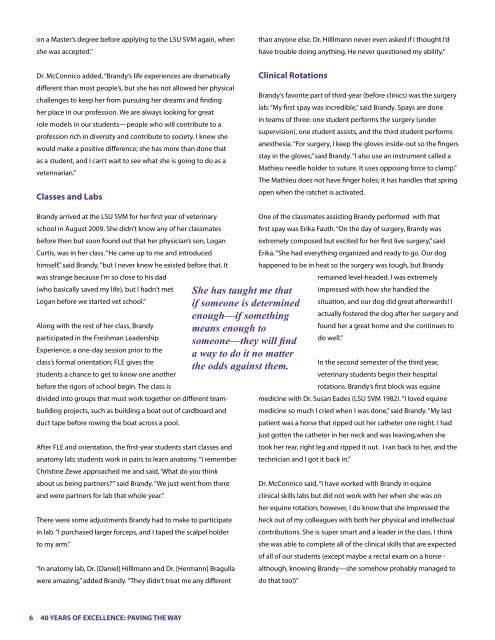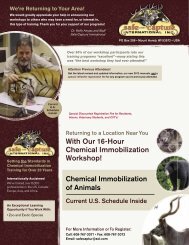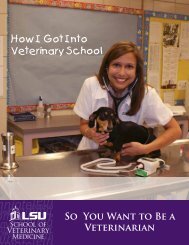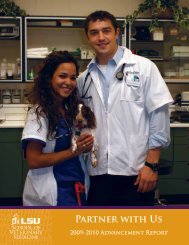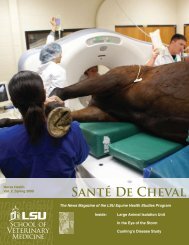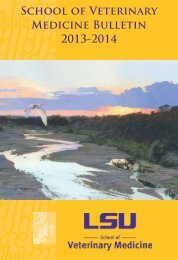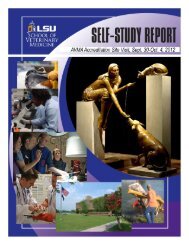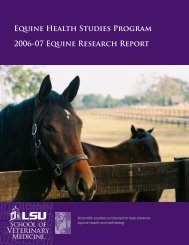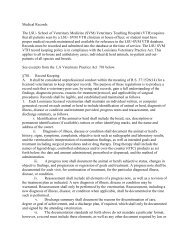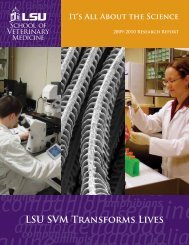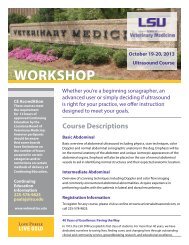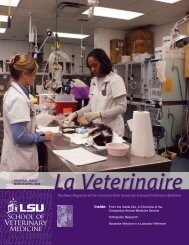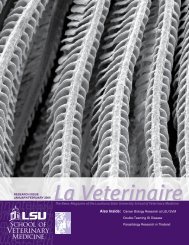Spring 2013 - School of Veterinary Medicine - Louisiana State ...
Spring 2013 - School of Veterinary Medicine - Louisiana State ...
Spring 2013 - School of Veterinary Medicine - Louisiana State ...
Create successful ePaper yourself
Turn your PDF publications into a flip-book with our unique Google optimized e-Paper software.
on a Master’s degree before applying to the LSU SVM again, when<br />
she was accepted.”<br />
than anyone else. Dr. Hilllmann never even asked if I thought I’d<br />
have trouble doing anything. He never questioned my ability.”<br />
Dr. McConnico added, “Brandy’s life experiences are dramatically<br />
different than most people’s, but she has not allowed her physical<br />
challenges to keep her from pursuing her dreams and finding<br />
her place in our pr<strong>of</strong>ession. We are always looking for great<br />
role models in our students—people who will contribute to a<br />
pr<strong>of</strong>ession rich in diversity and contribute to society. I knew she<br />
would make a positive difference; she has more than done that<br />
as a student, and I can’t wait to see what she is going to do as a<br />
veterinarian.”<br />
Classes and Labs<br />
Clinical Rotations<br />
Brandy’s favorite part <strong>of</strong> third-year (before clinics) was the surgery<br />
lab. “My first spay was incredible,” said Brandy. Spays are done<br />
in teams <strong>of</strong> three: one student performs the surgery (under<br />
supervision), one student assists, and the third student performs<br />
anesthesia. “For surgery, I keep the gloves inside-out so the fingers<br />
stay in the gloves,” said Brandy. “I also use an instrument called a<br />
Mathieu needle holder to suture. It uses opposing force to clamp.”<br />
The Mathieu does not have finger holes; it has handles that spring<br />
open when the ratchet is activated.<br />
Brandy arrived at the LSU SVM for her first year <strong>of</strong> veterinary<br />
school in August 2009. She didn’t know any <strong>of</strong> her classmates<br />
before then but soon found out that her physician’s son, Logan<br />
Curtis, was in her class. “He came up to me and introduced<br />
himself,” said Brandy, “but I never knew he existed before that. It<br />
was strange because I’m so close to his dad<br />
(who basically saved my life), but I hadn’t met<br />
Logan before we started vet school.”<br />
Along with the rest <strong>of</strong> her class, Brandy<br />
participated in the Freshman Leadership<br />
Experience, a one-day session prior to the<br />
class’s formal orientation; FLE gives the<br />
students a chance to get to know one another<br />
before the rigors <strong>of</strong> school begin. The class is<br />
divided into groups that must work together on different teambuilding<br />
projects, such as building a boat out <strong>of</strong> cardboard and<br />
duct tape before rowing the boat across a pool.<br />
After FLE and orientation, the first-year students start classes and<br />
anatomy lab; students work in pairs to learn anatomy. “I remember<br />
Christine Zewe approached me and said, ‘What do you think<br />
about us being partners’” said Brandy. “We just went from there<br />
and were partners for lab that whole year.”<br />
There were some adjustments Brandy had to make to participate<br />
in lab. “I purchased larger forceps, and I taped the scalpel holder<br />
to my arm.”<br />
“In anatomy lab, Dr. [Daniel] Hilllmann and Dr. [Hermann] Bragulla<br />
were amazing,” added Brandy. “They didn’t treat me any different<br />
She has taught me that<br />
if someone is determined<br />
enough—if something<br />
means enough to<br />
someone—they will find<br />
a way to do it no matter<br />
the odds against them.<br />
One <strong>of</strong> the classmates assisting Brandy performed with that<br />
first spay was Erika Fauth. “On the day <strong>of</strong> surgery, Brandy was<br />
extremely composed but excited for her first live surgery,” said<br />
Erika. “She had everything organized and ready to go. Our dog<br />
happened to be in heat so the surgery was tough, but Brandy<br />
remained level-headed. I was extremely<br />
impressed with how she handled the<br />
situation, and our dog did great afterwards! I<br />
actually fostered the dog after her surgery and<br />
found her a great home and she continues to<br />
do well.”<br />
In the second semester <strong>of</strong> the third year,<br />
veterinary students begin their hospital<br />
rotations. Brandy’s first block was equine<br />
medicine with Dr. Susan Eades (LSU SVM 1982). “I loved equine<br />
medicine so much I cried when I was done,” said Brandy. “My last<br />
patient was a horse that ripped out her catheter one night. I had<br />
just gotten the catheter in her neck and was leaving,when she<br />
took her rear, right leg and ripped it out. I ran back to her, and the<br />
technician and I got it back in.”<br />
Dr. McConnico said, “I have worked with Brandy in equine<br />
clinical skills labs but did not work with her when she was on<br />
her equine rotation; however, I do know that she impressed the<br />
heck out <strong>of</strong> my colleagues with both her physical and intellectual<br />
contributions. She is super smart and a leader in the class. I think<br />
she was able to complete all <strong>of</strong> the clinical skills that are expected<br />
<strong>of</strong> all <strong>of</strong> our students (except maybe a rectal exam on a horse -<br />
although, knowing Brandy—she somehow probably managed to<br />
do that too!)”<br />
6 40 YEARS OF EXCELLENCE: PAVING THE WAY


